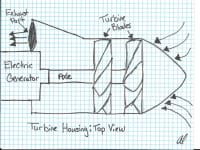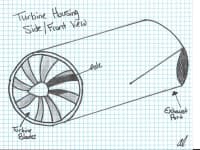The high speed (high RPM) wind turbine is designed to be used in vehicles with forward motion that produce air drag. The goal of this turbine is to capture the air that would normally pass through unused space in a vehicle.
The main uses for this design would in the automotive industry, however,the design could be used in a number of other battery run vehicles. Electric cars have the potential to greatly shape our future and reduce our carbon footprint but their limitations in distance causes consumers to second guess this as a viable option. These turbines would act to spin an electric generator that would be able to provide extra charge to the battery while driving. This added charge would extend the miles per charge of current electric vehicles.
As any vehicle moves forward, it encounters air resistance. By placing small wind turbines in the unused "engine compartment" of electric vehicles, that force can be harnessed. The system would used a cylindrical shaped housing around a series of blades to draw air across them that is being encountered from the forward motion of the vehicle. Just as in any standard turbine, this would rotate an axle attached to an electric generator to produce an electric charge. The design features an exhaust port on the side that can be shaped and vented along side the vehicle. In a car, this could exhaust out of the front fender. This would allow air to continuously flow across the turbine blades as the car is moving forward without adding drag to the vehicle. The generator would need to handle high RPMs for power generation. Due to the high speeds of the air being forced across the turbine blades, the generator could be relatively small. Unlike standard wind turbines that use large blades to rotate an axle that is connected to a set of gears to produce power, the generator in this high RPM turbine would use the force and speed of the air entering the turbine to produce power. The faster the vehicle is traveling, the higher the speed of air it encounters. This would mean that the most electricity would be produced when the vehicle is at highway speeds, when the vehicle is using the least amount of energy for driving allowing for a positive production of energy in the vehicle.
This type of energy production along with current set-ups that utilize regenerative breaking would extend the battery charge of any electric vehicle. This is a system that could be added to existing electric vehicles and ones already in production. Without needing to change the designs of vehicles to integrate with this product, the cost associated would be relatively low. This product could be sold as an aftermarket add-on as well to help increase the profitability. By addressing the 'miles per charge' issues with current electric vehicles, the marketability of electric vehicles increases greatly, helping to lessen the global carbon footprint with each purchase.
Like this entry?
-
About the Entrant
- Name:Alexander Levanduski
- Type of entry:individual
- Patent status:none





